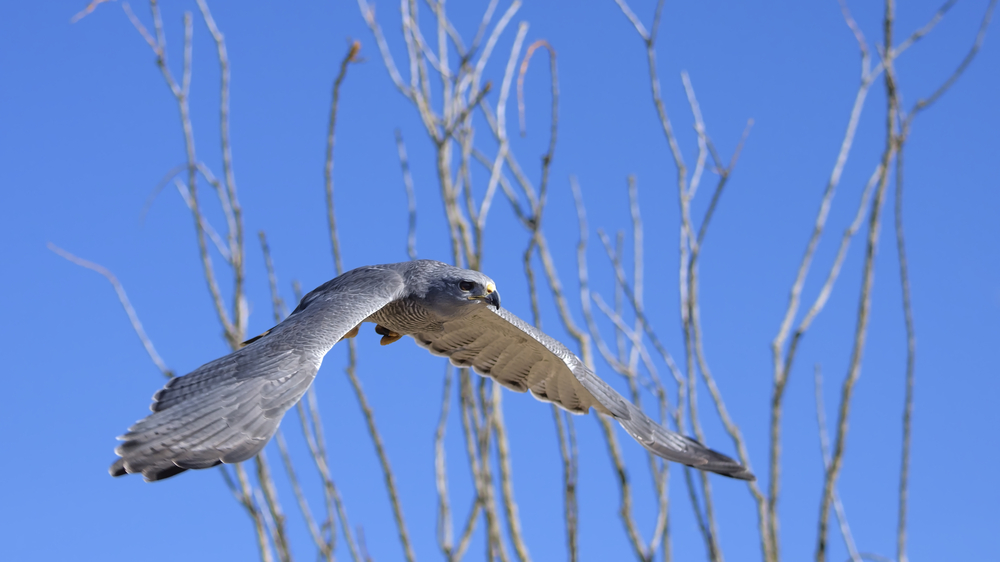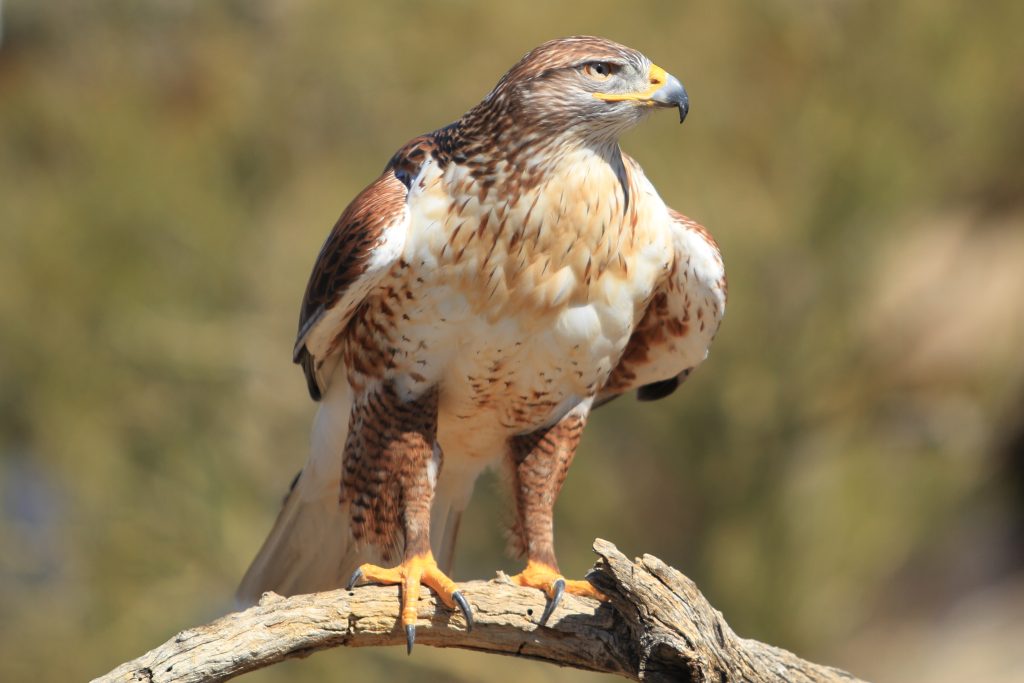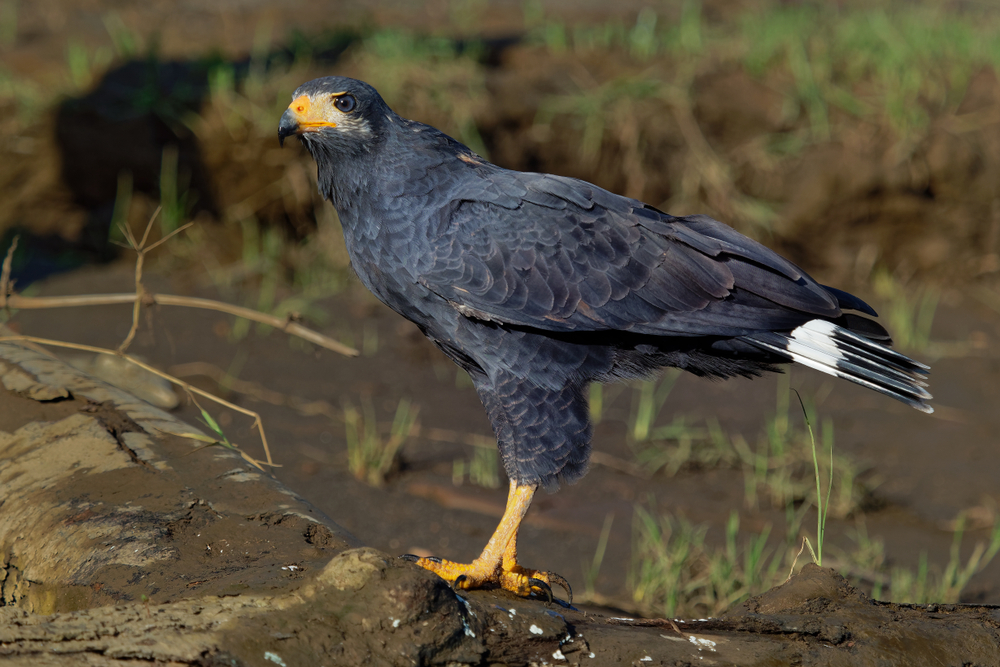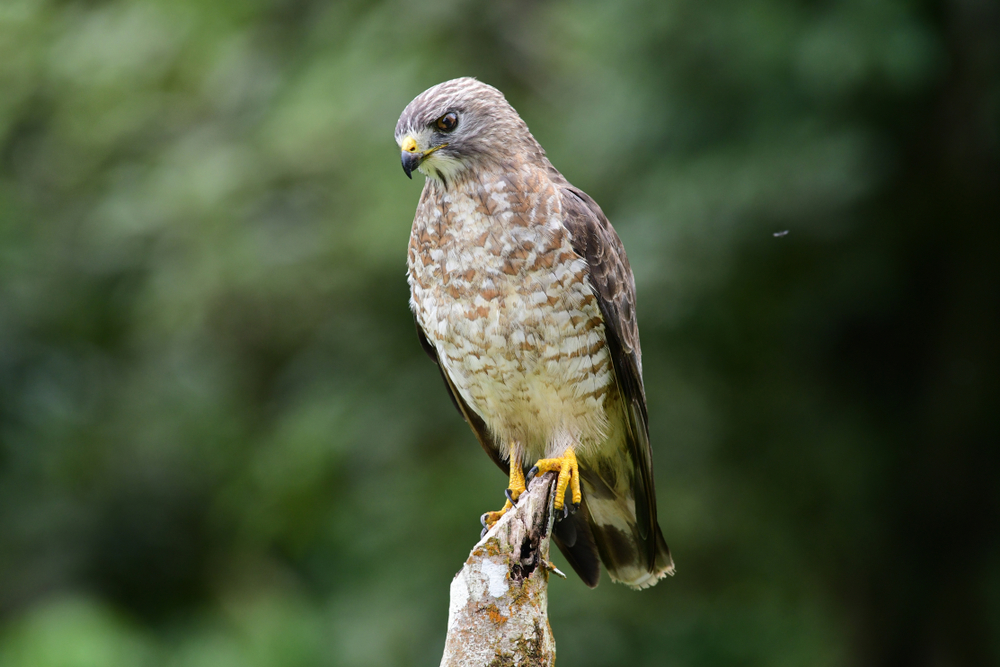The Gray Hawk’s closest relatives are other members of the Buteogallus and Buteo groups, especially the Roadside Hawk (Rupornis magnirostris) and the Common Black Hawk (Buteogallus anthracinus). These species share overlapping ranges and similar riparian or woodland habits, though the Gray Hawk is slimmer and more reptile-focused.
About
The Gray Hawk (Buteo plagiatus) is a medium-sized raptor of the Accipitridae family, found in the southwestern United States, Mexico, Central America, and parts of South America. Favoring river valleys, woodlands, and semi-open habitats, it is often associated with areas near water where prey is plentiful. Known for its graceful flight and striking plumage, the Gray Hawk is one of the most elegant hawks of the Americas.
This species measures 46 to 61 centimeters (18 to 24 inches) in length, with a wingspan of 110 to 127 centimeters (43 to 50 inches). Adults are characterized by their pale gray body, finely barred chest, and broad, rounded wings. The tail is boldly patterned with three black bands alternating with white, creating a distinctive look in flight. Juveniles are brown with streaked underparts and gradually acquire adult plumage as they mature.
Gray Hawks primarily feed on reptiles, especially lizards, which make up the bulk of their diet. They also take small mammals, birds, and large insects. Their hunting style typically involves perching quietly on a tree branch, then swooping down swiftly to capture prey on the ground or in vegetation.
Breeding occurs in spring, with nests built high in trees, often in riparian woodlands. The nest is a bulky platform of sticks lined with leaves. Females usually lay two to three eggs, and both parents take part in raising the chicks. During the breeding season, Gray Hawks are known for their distinctive high-pitched calls, which carry across their territories.
The species is currently listed as Least Concern, with stable populations in Central and South America, though it remains uncommon and localized in the United States due to limited habitat availability.
Graceful, vocal, and specialized, the Gray Hawk is a striking representative of riparian ecosystems in the Americas.
Physical Characteristics
The Gray Hawk (Buteo plagiatus) is a medium-sized raptor of the American Southwest, Mexico, and Central America, known for its pale gray plumage and graceful flight.
-
Plumage: Adults are light gray overall with fine white barring on the chest and belly. The wings are gray above and pale underneath with dark tips. Juveniles are brown above with streaked underparts and banded tails, gradually molting into adult plumage.
-
Face: The head is rounded and pale gray with a sharp, hooked black bill and a yellow cere. Eyes are dark brown.
-
Body: Slender and elegant compared to bulkier hawks, with a streamlined chest and long legs.
-
Wings: Broad and rounded, adapted for soaring above riparian woodlands. In flight, the underwing shows a pale gray surface with darker trailing edges.
-
Tail: Distinctive, long, and broadly banded with alternating black-and-white stripes, ending with a white tip—a key identification feature.
-
Feet: Bright yellow, strong, and equipped with sharp talons adapted for grasping reptiles and other small prey.
Size:
-
Length: About 18 to 24 in (46 to 61 cm).
-
Wingspan: Between 33 to 41 in (84 to 105 cm).
-
Weight: Ranges from 13 to 18 oz (370 to 510 g), with females slightly larger than males.
The Gray Hawk’s striking black-and-white tail bands, light gray body, and graceful soaring flight make it one of the most distinctive and elegant raptors of the American tropics and southwestern U.S.
Reproduction
The reproductive cycle of the Gray Hawk is strongly tied to riparian woodlands and open forests near rivers, where nests are built in tall trees.
-
Mating and Courtship:
-
Gray Hawks are monogamous, with pairs often reuniting each year.
-
Courtship displays include soaring together in circles, steep dives, and loud, high-pitched calls to reinforce pair bonds.
-
-
Nesting:
-
Nests are built high in tall trees, often cottonwoods or other riparian species, about 20 to 50 ft (6 to 15 m)above ground.
-
Nests are constructed of sticks and lined with leaves, green twigs, and softer plant material.
-
Pairs often reuse the same nesting territory annually, sometimes refurbishing old nests.
-
-
Egg Laying and Incubation:
-
The female usually lays 1 to 3 eggs, bluish-white with occasional brown speckles.
-
Incubation lasts about 33 to 35 days, mainly by the female while the male hunts and provides food.
-
-
Chick Development:
-
Chicks hatch covered in white down and are brooded closely during their first weeks.
-
Both parents feed the young, bringing reptiles, birds, and small mammals to the nest.
-
-
Fledging and Independence:
-
Young fledge at around 6 to 7 weeks of age, gradually learning to fly and hunt while still dependent on parents for food.
-
Juveniles disperse later in the season but may remain near the breeding territory before migrating south.
-
The Gray Hawk’s breeding success depends heavily on the availability of large riparian trees for nesting, making the preservation of river habitats essential to its reproductive cycle.
Lifespan
The Gray Hawk (Buteo plagiatus) is a riparian and forest-edge raptor with a moderate lifespan shaped by migration, habitat needs, and predation pressures.
-
Lifespan in the Wild:
Gray Hawks generally live 7 to 12 years in the wild, with some individuals reaching up to 15 years. Juvenile mortality is high, as many young fail to survive their first year due to predation or limited hunting success. -
Lifespan in Captivity:
In rehabilitation centers or aviaries, Gray Hawks may live longer—sometimes up to 20 years—because they are protected from predators and provided with steady food and medical care.
Threats to the Gray Hawk:
-
Habitat Loss: Destruction of riparian forests, especially cottonwood and willow stands, reduces suitable nesting and hunting sites.
-
Predation: Eggs and chicks are vulnerable to snakes, raccoons, and larger raptors such as Great Horned Owls.
-
Migration Hazards: Long migrations expose them to storms, exhaustion, and collisions with human-made structures.
-
Food Scarcity: Declines in reptile and small mammal populations impact survival and breeding success.
Although currently listed as a species of Least Concern, Gray Hawk populations in the United States are limited to the Southwest and are highly dependent on the conservation of riparian ecosystems.
Eating Habits
Gray Hawks are specialized hunters of warm, riparian habitats, with a diet dominated by reptiles.
-
Diet:
Their primary prey includes lizards (especially whiptail lizards), snakes, small mammals, birds, and large insects. In some areas, lizards may make up the majority of their diet. -
Foraging Strategy:
They are perch hunters, scanning from a branch or tree along rivers and then swooping down quickly to capture prey on the ground.
Occasionally, they soar low over woodlands or fields to flush out prey. -
Hunting Behavior:
Gray Hawks rely on short, fast strikes rather than long chases. They seize prey with their sharp talons, often killing reptiles with a quick bite or by tearing with their hooked bill. -
Feeding the Young:
Both parents provide food to chicks, tearing lizards, snakes, or small mammals into manageable pieces before feeding. -
Seasonal Variation:
During the breeding season in the U.S. Southwest, reptiles dominate their diet, while in their tropical wintering range, they expand to include more small birds, mammals, and insects.
The Gray Hawk’s strong dependence on reptiles makes it unique among North American raptors and ties its survival closely to the health of riparian and desert-edge ecosystems.
Uniqueness
The Gray Hawk (Buteo plagiatus) is a slender, graceful raptor with several traits that make it stand out among North American hawks:
-
Reptile Specialist: Unlike most hawks that rely heavily on mammals, Gray Hawks primarily hunt lizards and snakes, especially whiptails, making them one of the most reptile-dependent raptors in their range.
-
Riparian Dependency: They are strongly tied to riparian forests, especially cottonwood and willow stands along rivers, making them highly sensitive to habitat loss.
-
Striking Tail Bands: Their long black-and-white banded tail is one of their most distinctive field marks, flashing boldly in flight.
-
Graceful Flight: Known for buoyant, elegant soaring with slow, deliberate wingbeats—earning them a reputation as one of the most graceful hawks to watch.
-
Tropical to Temperate Migrant: While widespread in Central and South America, in the U.S. they are restricted to the Southwest, where they are considered rare and local breeders.
-
Indicator Species: Because of their dependence on healthy river systems, their presence signals the ecological health of riparian habitats.
The Gray Hawk’s reptile-based diet, elegant flight, and reliance on river woodlands make it one of the most unique and ecologically specialized hawks in the Americas.
Be the First to Share Photos of This Species.
FAQ’s
1. What is the species closest to the Gray Hawk?
2. How does the Gray Hawk compare to other hawks?
Gray Hawks are smaller and more slender than Red-tailed or Ferruginous Hawks, but larger than Sharp-shinned or Cooper’s Hawks. Unlike most hawks, they rely heavily on reptiles, especially lizards, rather than mammals or birds. They are also known for their graceful, buoyant flight, which makes them stand out among North American raptors.
3. What national parks provide an opportunity to see the Gray Hawk?
Gray Hawks can be seen in riparian habitats of the U.S. Southwest and Central America, including:
-
Big Bend National Park (Texas) – a reliable site along the Rio Grande.
-
Saguaro National Park (Arizona) – nesting pairs occur in riparian corridors.
-
Chiricahua National Monument (Arizona) – suitable forested canyons.
-
Corcovado National Park (Costa Rica) – strong populations in tropical lowland forests.
These parks protect the river and woodland habitats essential for Gray Hawks’ survival.







































































